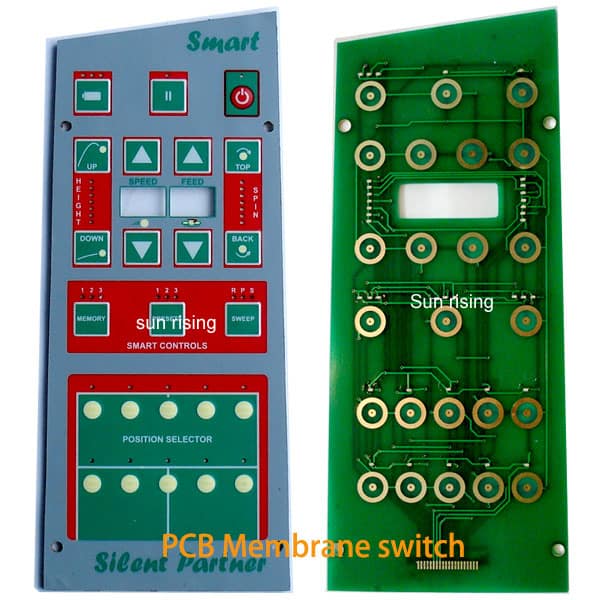Membrane Layer Switch Over Modern Technology: The Trick to Reliable and Cost-Effective User Interfaces
Membrane button technology has actually emerged as a crucial element in the design of customer interfaces, offering both integrity and cost-effectiveness across a varied variety of applications. As we discover the diverse benefits of membrane buttons, their capacity for technology increases inquiries concerning future applications and developing fads.
Comprehending Membrane Layer Switch Modern Technology
Membrane button technology is a commonly made use of interface remedy in various digital tools, providing a smooth mix of functionality and layout. This technology integrates numerous layers of materials, normally being composed of a graphic overlay, spacer layer, and a circuit layer. The graphic overlay presents the user interface elements, while the spacer layer separates the circuit layer from the overlay till a user activates a button.
When stress is used to the overlay, the circuit layer completes the electrical circuit, sending out a signal to the tool. This mechanism enables for various setups, consisting of responsive feedback and backlighting options, improving individual communication. Membrane layer buttons are generally produced making use of sturdy products such as polyester or polycarbonate, ensuring longevity and resistance to environmental aspects like wetness and dirt.
The convenience of membrane layer switches over allows their application in varied sectors, consisting of clinical tools, consumer electronics, and commercial controls. Their small layout allows for integration into space-constrained environments, providing an efficient interface without compromising aesthetic appeal. Understanding the intricacies of membrane button modern technology is essential for manufacturers and developers looking for to develop trusted and reliable human-machine user interfaces.
Secret Benefits of Membrane Layer Buttons
While different interface services exist, membrane switches over deal unique advantages that make them a preferred selection in many applications. One of the primary advantages is their longevity; membrane layer switches are designed to hold up against rough environmental conditions, consisting of wetness, dust, and temperature variations, making sure lasting efficiency. This durability considerably reduces the requirement for frequent substitutes, consequently lowering total maintenance prices.

In addition, membrane switches are lightweight and small, making them ideal for applications where room is limited. Their low-profile style adds to a streamlined look without endangering functionality.
Cost-effectiveness is likewise a significant benefit, as the production procedure for membrane layer switches tends to be less costly find more compared to typical mechanical switches. This price, integrated with their dependability and simplicity of installation, have a peek at this site settings membrane changes as a sensible option for a variety of industries looking for reliable and reliable interface.
Applications Throughout Different Industries
Exactly how do membrane buttons adapt to the varied needs of numerous markets? Membrane layer switch technology is significantly recognized for its convenience, making it appropriate for a wide variety of applications throughout several sectors.
In customer electronic devices, membrane buttons provide a small solution for push-button controls and home appliances, improving user experience with instinctive style. In addition, the industrial market leverages membrane switches for equipment control panels, taking advantage of their resistance to rough environments, such as wetness and dirt.
Military and aerospace applications likewise make use of membrane switches for their integrity and ability to stand up to extreme conditions, making sure operational performance in vital scenarios. The food and beverage industry embraces these switches for automated systems, where cleanliness and convenience of procedure are paramount (membrane switch). Ultimately, membrane switches are tailored to satisfy the special needs of each sector, proving their important function in contemporary technology user interfaces
Style and Personalization Alternatives

In the world of membrane layer button modern technology, layout and modification alternatives play a crucial duty in improving performance and individual interaction. These switches can be customized to fulfill certain operational requirements and aesthetic choices, making them flexible elements in various applications.
One of the key modification choices is the layout of the button itself, which can be made to fit distinct user interfaces and ergonomic considerations. By readjusting the shape, size, and arrangement of switches, suppliers can produce intuitive layouts that assist in simplicity of usage. Furthermore, the consolidation of various shades and graphic overlays permits branding and enhanced visibility, making certain that individuals can quickly recognize functions.
Moreover, membrane layer buttons can be engineered with various responsive feedback devices, such as raised switches or audible clicks, to boost the user experience. Various materials can additionally be selected for longevity and environmental resistance, addressing aspects such as moisture, temperature level fluctuations, and chemical direct exposure.
Inevitably, the substantial layout and personalization alternatives available in membrane layer button innovation encourage businesses to create customized options that not just fulfill practical needs but likewise straighten with their branding and operational requirements.

Future Fads in Membrane Switches
As membrane layer button technology continues to progress, future fads are increasingly focused on improving individual experience and incorporating advanced performances. One substantial fad is the integration of touch-sensitive and capacitive technologies into standard membrane layer buttons. This growth permits more intuitive interface, offering tactile comments while preserving a smooth style.
One more emerging pattern is the usage of eco-friendly materials, driven by the growing demand for moved here sustainable manufacturing practices. Manufacturers are seeking to reduce their carbon footprint by making use of recyclable substratums and low-impact inks, straightening with international sustainability objectives.
Additionally, the increase of the Web of Things (IoT) is prompting the incorporation of clever attributes right into membrane switches. Enhanced connection alternatives will enable devices to connect with each various other, permitting seamless integration right into wider systems.
Furthermore, developments in printing technologies, such as electronic printing, are permitting greater design adaptability and personalization. This enables manufacturers to generate complex designs and dynamic colors cost-effectively.

Verdict
In final thought, membrane layer switch innovation stands for a vital development in customer interface layout, offering considerable benefits in durability, personalization, and cost-effectiveness. As improvements proceed to arise, particularly in touch-sensitive interfaces and sustainable materials, the possibility for membrane layer switches over to enhance user experience and performance stays appealing.